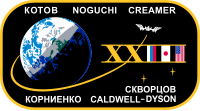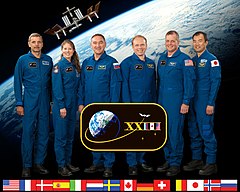Ekspedycja 23
 | |
| Dane misji | |
| Oznaczenie kodowe | Ekspedycja 23 |
|---|---|
| Pojazd | |
| Pojazd dowożący | |
| Pojazd powrotny | Sojuz TMA-17 |
| Załoga | |
 od lewej: M. Kornijenko, T. Caldwell Dyson, A. Skworcow, O. Kotow, T. Creamer i S. Noguchi | |
| Załoga | 6 |
| Start | |
| Miejsce startu | |
| Początek misji | 18 marca 2010 |
| Misja ISS | |
| Lądowanie | |
| Miejsce lądowania | |
| Lądowanie | 2 czerwca 2010[1] |
| Międzynarodowa Stacja Kosmiczna | |
Ekspedycja 23 – dwudziesta trzecia ekspedycja na Międzynarodową Stację Kosmiczną, która rozpoczęła się 18 marca 2010, a zakończyła się 2 czerwca 2010 o 00:04 UTC[2] w momencie odcumowania statku Sojuz TMA-17 z trzema członkami ekspedycji. Pozostali trzej członkowie stali się członkami Ekspedycji 24. Członkowie załogi ekspedycji przybyli na ISS na pokładach rosyjskich statków Sojuz TMA-17 i Sojuz TMA-18.
Załoga
Załoga stacji składała się z sześciorga członków, trzech z nich (Oleg Kotow, Timothy Creamer i Sōichi Noguchi) przeszło z Ekspedycji 22, pozostali troje przylecieli na stację 4 kwietnia 2010 na pokładzie Sojuza TMA-18:
- Oleg Kotow (2) Dowódca – Roskosmos
- Timothy Creamer (1) Inżynier pokładowy 1 – NASA
- Sōichi Noguchi (2) Inżynier pokładowy 2 – JAXA
- Aleksandr Skworcow (1), Inżynier pokładowy 3 – Roskosmos
- Michaił Kornijenko (1), Inżynier pokładowy 4 – Roskosmos
- Tracy Caldwell Dyson (2), Inżynier pokładowy 5 – NASA
Liczba w nawiasie oznacza liczbę lotów odbytych przez każdego z astronautów, łącznie z Ekspedycją 23.
Zobacz też
Przypisy
- ↑ Soyuz TMA-17 Crew Capsule Lands Safely in Kazakhstan (ang.). pravda.ru, 2 czerwca 2010. [dostęp 2010-06-03].
- ↑ ISS On-Orbit Status 06/02/10 (ang.). nasa.gov, 2 czerwca 2010. [dostęp 2010-06-04].
Linki zewnętrzne
- Ekspedycja 23 na stronie NASA (ang.)
- ISS: Expedition 23 (ang.). Space Facts, 2014-07-05. [dostęp 2014-07-13].
Media użyte na tej stronie
Expedition 23 crew members. From the left are Russian cosmonaut Mikhail Kornienko, NASA astronaut Tracy Caldwell Dyson, Russian cosmonaut Alexander Skvortsov, all flight engineers; Russian cosmonaut Oleg Kotov, commander; NASA astronaut T.J. Creamer and Japan Aerospace Exploration Agency (JAXA) astronaut Soichi Noguchi, both flight engineers.
The focal point of the Expedition XXIII emblem illustrates the beautiful planet Earth in the black expanse of space. The International Space Station (ISS) is shown traveling in its orbit around Earth. The ISS orbital path flies through the XXIII to show that this increment is building upon the missions that have gone on before and laying the groundwork for future missions. This illustrates the work being performed aboard the orbiting complex that will lead the way to eventual missions to the moon, Mars and beyond. The mission designation uses Roman numerals to illustrate the home nations of the crew, which are also represented by their national flags. The two stars represent the two teams that make up this expedition crew.



